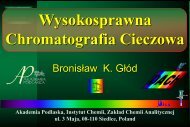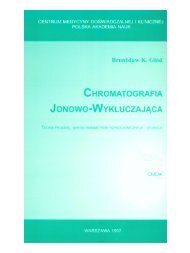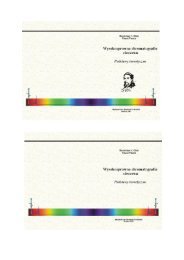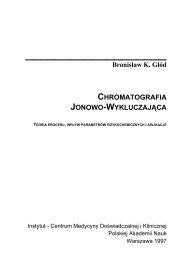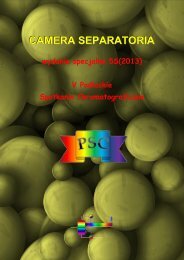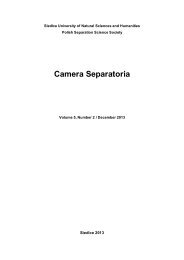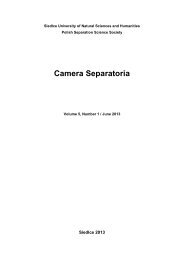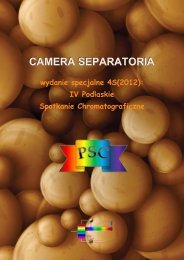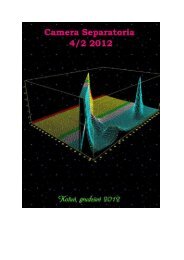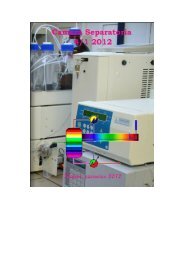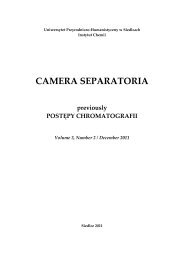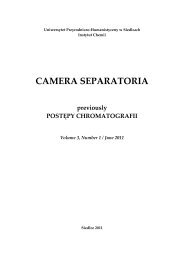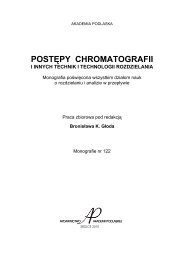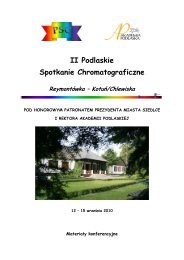CamSep 3 S
You also want an ePaper? Increase the reach of your titles
YUMPU automatically turns print PDFs into web optimized ePapers that Google loves.
EXTRACTION STUDY OF SPIRULINA AND HERB DYES<br />
FROM SELECTED PHARMACEUTICAL FORMULATIONS<br />
AND FOOD PRODUCTS<br />
Magdalena B. ZARZYCKA a , Paweł K. ZARZYCKI a , Vicki L. CLIFTON b ,<br />
Jerzy ADAMSKI c , Bronisław K. GŁÓD d<br />
/Stosowana w pracy technika rozdzielania: micro-TLC/<br />
a Section of Toxicology and Bioanalytics, Department of Civil and Environmental Engineering, Koszalin<br />
University of Technology, Śniadeckich 2,75-453 Koszalin, Poland.<br />
b The Robinson Institute, School of Paediatrics and Reproductive Health, Lyell MCEwin Hospital, University<br />
of Adelaide, Haydown Rd, Elizabethvale 5112 SA, Australia.<br />
c Helmholtz Zentrum Muenchen, Institute of Experimental Genetics, Genome Analysis Center, Ingolstaedter<br />
Landstr.1, 85764 Neuherberg, Germany.<br />
d Department of Analytical Chemistry, Institute of Chemistry, Faculty of Science, University of Podlasie,<br />
3 Maja 54, 08–110 Siedlce, Poland.<br />
This work is continuation of our research focusing on development of micro-TLC platform<br />
for the fast analysis of low-molecular mass compounds from spirulina samples [1-5]. Based on our<br />
previous research examining the fractionation of spirulina dyes using number of water and organic<br />
liquids, in this study the target compounds were extracted using three relatively low-parachor<br />
liquids: methanol, acetone and tetrahydrofuran. We analyzed a number of the spirulina samples,<br />
which were originated from pharmaceutical formulations and food products as well as rich in<br />
chlorophyll dyes herb samples used as the reference materials. Quantitative data derived from<br />
micro-plates under visible light conditions and after iodine staining were explored using simple<br />
chemometrics tools including cluster analysis and principal components analysis (PCA). Using this<br />
method we could easily distinguish genuine spirulina and non-spirulina samples (Figure 1) as well<br />
as fresh from expired commercial products. It has been found that comparison of the PCA patterns<br />
derived from different extraction liquids can be usefull for preliminary chemotaxonomic<br />
classification of the samples investigated. Described approach allows non-expensive fractionation<br />
of target substances including cyanobacteria pigments in raw biological or environmental samples.<br />
Due to the low consumption of the mobile phase, micro-TLC method can be considered as<br />
environmentally friendly and green chemistry analytical tool.<br />
Figure 1. Principal component plots showing relationships between samples investigated with respect to 1, 2<br />
and 3 factor scores, using methanol, acetone and tetrahydrofurane extraction liquids. Objects marked as<br />
black balls correspond to genuine spirulina products.<br />
References<br />
[1] P. K. Zarzycki, M. B. Zarzycka, J. AOAC Int. 91 (2008) 1196. [2] P. K. Zarzycki, M. B. Zarzycka, B. K. Głód,<br />
PAK, 55 (2009) 276. [3] P. K. Zarzycki, M. B. Zarzycka, M. M. Ślączka, V. L. Clifton, Anal. Bioanal. Chem. 397<br />
(2010) 905. [4] P. K. Zarzycki, M. M. Ślączka, M. B. Zarzycka, E. Włodarczyk, M. J. Baran, Anal. Chim. Acta, 688<br />
(2011) 168. [5] P.K. Zarzycki, M.B. Zarzycka, V.L. Clifton, J. Adamski, B.K. Głód, J. Chromatogr A. In press.<br />
17




